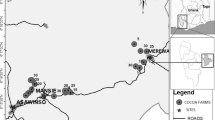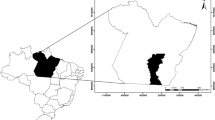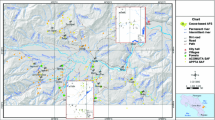Abstract
Cacao (Theobroma cacao) cultivation maintaining a high proportion of shade trees in a diverse composition (agroforestry) is currently being viewed as a sustainable land use practice. Our research hypothesis was that cacao agroforests (AF) can support relatively high tree diversity, as compared to surrounding primary and/or secondary forests. The objective of this study was to assess the impact of forest conversion on tree communities by comparing tree composition, community characteristics (richness and diversity) and spatial structure (density, canopy height, basal area) among primary forest, secondary forest, and cacao AF. In total, we collected data from 30 25 × 25 m plots on three land use systems (20 in cacao AF, five in secondary, and five in primary forests) in San Alejandro, Peruvian Amazon. All trees with DBH ≥ 10 cm were counted, identified to species, and their height and DBH were recorded. Our results support the hypothesis that cacao AF present a relatively high tree species richness and diversity, although they are no substitute for natural habitats. We identified most common species used for shading cacao. Tree species composition similarity was highest between cacao AF and secondary forest. Vegetation structure (density, height, DBH) was significantly lower compared to primary and secondary forest. Species richness and diversity were found to be highest in the primary forest, but cacao AF and secondary forests were fairly comparable. The tree species cultivated in cacao AF are very different from those found in primary forest, so we question whether the relatively high tree diversity and richness is able to support much of the diversity of original flora and fauna.




Similar content being viewed by others
References
Anduaga RS (2009) Situación y Perspectivas de la Cadena del Cacao Chocholate en el Perú. IICA, Lima
Anglaaere LCN, Cobbina J, Sinclair FL, McDonald MA (2011) The effect of land use systems on tree diversity: farmer preference and species composition of cacao-based agroecosystems in Ghana. Agrofor Syst 81:249–265
Asase A, Tetteh DA (2010) The role of complex agroforestry systems in the conservation of forest tree diversity and structure in southeastern Ghana. Agrofor Syst 79:355–368
Asase A, Ofori-Frimpong K, Ekpe PK (2009) Impact of cocoa farming on vegetation in an agricultural landscape in Ghana. J Afr Ecol 48:338–346
Atkins JE, Eastin I (2012) Farmers perceptions of indigenous forest trees within the cultivated cocoa landscape. Forestry Chron 88(5):535–541
Bobo K, Waltert M, Sainge NM, Njokagbo N, Fermon H, Muhlenberg M (2006) From forest to farmland: species richness patterns of trees and understorey plants along a gradient of forest conversion in southwestern Cameroon. Biodiv Conserv 15:4097–4117
Chao A, Chazdon RL, Colwell RK, Shen TJ (2005) A new statistical approach for assessing compositional similarity based on incidence and abundance data. Ecol Lett 8:148–159
Colwell RK (2009) Estimates: statistical estimation of species richness and shared species from samples, version 8.2. Persistent http://purl.oclc.org/estimates
Daghela Bisseleua HB, Herve B, Vidal S (2007) Plant biodiversity and vegetation structure in traditional cocoa forest gardens in southern Cameroon under different management. Biodiv Conserv 17:1821–1835
Daghela Bisseleua HB, Fotio D, Yede Missoup AD, Vidal S (2013) Shade tree diversity, cocoa pest damage, yield compensating inputs and farmers’ net returns in West Africa. PLoS One 8(3):e56115
Deheuvels O, Avelino J, Somarriba E, Malezieux E (2012) Vegetation structure and productivity in cocoa-based agroforestry systems in Talamanca, Costa Rica. Agric Ecosyst Environ 149:181–188
Duguma B, Gockowski J, Bakala J (2001) Smallholder Cacao (Theobroma cacao) cultivation in agroforestry systems of West and Central Africa: challenges and opportunities. Agrofor Syst 51:177–188
FAO (2011) FAOSTAT crop production. (http://faostat3.fao.org) [online]. Available at http://faostat3.fao.org/faostat-gateway/go/to/download/Q/QC/E. Accessed Sept 20, 2013
Fazey I, Fischer J, Lindenmayer DB (2005) What do conservation biologists publish? Biol Conserv 124:63–73
García Carrion LF (2010) Catálogo de Cultivares de Cacao del Perú. Ministerio de Agricultura Dirección General de Competividad Agraria, Lima 112 pp
Gascon G, Williamson GB, da Fonseca GAB (2000) Receding forest edges and vanishing reserves. Science 288:1356–1358
Gonzales TT (2008) Plan vial provincial participativo de Padre Abad. Municipalidad provincial de Padre Abad, Pucallpa
Gotelli NJ, Colwell RK (2001) Quantifying biodiversity: procedures and pitfalls in the measurement and comparison of species richness. Ecol Lett 4:379–391
Harvey CA, González JAV (2007) Agroforestry systems conserve species-rich but modified assemblages of tropical birds and bats. Biodivers Conserv 16:2257–2292
Harvey CA, González J, Somarriba E (2006) Dung beetle and terrestrial mammal diversity in forests, indigenous agroforestry systems and plantain monocultures in Talamanca, Costa Rica. Biodivers Conserv 15:555–585
Heltshe JF, Forrester NE (1983) Estimating species richness using the jackknife procedure. Biometrics 39:1–11
Kessler M, Kesler PJA, Gradstein SR, Bach K, Schmull M, Pitopang R (2005) Tree diversity in primary forest and different land use systems in Central Sulawesi, Indonesia. Biodiv Conserv 14:547–560
Koko LK, Snoeck D, Lekadou TT, Assiri AA (2013) Cacao-fruit tree intercropping effects on cocoa yield, plant vigour and light interception in Cote d’Ivoire. Agrofor Syst 87:1043–1052
Krebs CJ (1999) Ecological Methodology, vol Second. Addison Wesley Longman, Inc University of British Columbia, Canada
Lindenmayer DB (2010) Landscape change and the science of biodiversity conservation in tropical forests: a view from the temperate world. Biol Conserv 143:2405–2411
Magurran AE (2004) Measuring biological diversity. Blackwell Science Ltd, Malden
McNeely J, Schroth G (2006) Agroforestry and biodiversity conservation—traditional practices, present dynamics, and lessons for the future. Biodiv Conserv 15:549–554
Oke DO, Odebiyi KA (2007) Traditional cocoa-based agroforestry and forest species conservation in Ondo State, Nigeria. Agric Ecosyst Environ 122:305–311
Parthasarathy N (1999) Tree diversity and distribution in undisturbed and human-impacted sites of tropical wet evergreen forest in the southern Western Ghats, India. Biodiv Conserv 8:1365–1381
Peres CA, Gardner TA, Barlow J, Zuanon J, Michalski F, Lees AC, Vieira ICG, Moreira FMS, Feeley KJ (2010) Biodiversity conservation in human-modified Amazonian forest landscapes. Biol Conserv 143:2314–2327
Reynel C, Pennington RT, Pennington TD, Flores C, Daza A (2003) Árboles útiles de la Amazonía Peruana. Tarea Gráfica Educativa, Perú.
Rolim SG, Chiarello AG (2004) Slow death of Atlantic forest trees in cocoa agroforestry in southeastern Brazil. Biodivers Conserv 13:2679–2694
Sala OE, Chapin FS, Armesto JJ, Berlow E, Bloomfield J, Dirzo R, Huber-Sanwald E, Huenneke LF, Jackson RB, Kinzig A, Leemans R, Lodge DM, Mooney HA, Oesterhel M, Poff NL, Sykes M, Walker BH, Walker M, Wall DH (2006) Global biodiversity scenarios for the year 2100. Science 287:1770–1774
Sambuichi RHR, Haridasan M (2007) Recovery of species richness and conservation of native Atlantic forest trees in the cacao plantations of southern Bahia in Brazil. Biodivers Conserv 16:3681–3701
Sambuichi RHR, Widal DB, Piasentin FB, Jardim JG, Viana TG, Menezes AA, Mello DL, Ahnert D, Baligar VC (2012) Caburca agroforests in southern Bahia, Brazil: tree component, management practices and tree species conservation. Biodivers Conserv 21(4):1055–1077
Schroth G, Harvey CA (2007) Biodiversity conservation in cocoa production landscapes: an overview. Biodiv Conserv 16:2237–2244
Schroth G, Da Foneseca AB, Harvey CA, Gascon C, Vasconcelos HL, Izac AMN (2004) The role of agroforestry in biodiversity conservation in tropical landscapes. In: Schroth G et al (eds) Agroforestry and biodiversity conservation in tropical landscapes. Island Press, Washington, pp 1–12
Somarriba E, Beer J (2011) Productivity of Theobroma cacao agroforestry systems with timber or legume service shade trees. Agrofor Syst 81:109–121
Somarriba E, Harvey CA, Semper M, Anthony F, González J, Staver C, Rice RA (2004) Biodiversity conservation in Neotropical coffee (Coffea arabica) plantations. In: Schroth G, da Fonseca GAB, Harvey CA, Gascon C, Vasconcelos HL, Izac AMN (eds) Agroforestry and biodiversity conservation in tropical landscape. Island Press, Washington, pp 198–226
Sonwa DJ, Nkongmeneck BA, Weise SF et al (2007) Diversity of plants in cocoa agroforests in the humid forest zone of Southern Cameroon. Biodivers Conserv 16:2385–2400
Sotelo C, Vidaurre H, Weber J, Simons A, Dawson I (2000) Domesticación participativa de árboles agroforestales en la amazonia peruana. In: Congreso Forestal Latinoamericano 2000. Capítulo de Ingeniería Forestal, Lima, Perú
Turner IM (2001) The Ecology of trees in the tropical rainforest. Cambridge University, Cambridge
Turner IM, Wong YK, Chew PT, bin Ibrahim A (1997) Tree species richness in primary and old secondary tropical forest in Singapore. Biodiv Conserv 6:237–543
Van Dijk JM (1999) Non-timber forest products in the Bipindi-Akom Region, Cameroon: a socio-economic and ecological assessment. The Tropenbos-Cameroon Programme, Kribi
Whitmore TC, Sayer JA (1992) Tropical Deforestation and Species Extinction. Chapman & Hall, London
Acknowledgments
This research was supported by grants from The Czech Foundation for Development of Education; Foundation Nadání Josefa, Marie a Zdeňky Hlávkových; the Fulbright Commission in the Czech Republic and internal grant of the Faculty of Tropical AgriSciences, CULS Prague (N°20135121). We would like to thank to many people from Universidad Nacional Intercultural de la Amazonía, Universidad Nacional de Ucayali and local cacao farmers from the cooperative ACATPA in San Alejandro for their cooperation during our research. We also highly appreciate the work of two anonymous reviewers that substantially improved the quality of the manuscript.
Author information
Authors and Affiliations
Corresponding author
Rights and permissions
About this article
Cite this article
Vebrova, H., Lojka, B., Husband, T.P. et al. Tree diversity in cacao agroforests in San Alejandro, Peruvian Amazon. Agroforest Syst 88, 1101–1115 (2014). https://doi.org/10.1007/s10457-013-9654-5
Received:
Accepted:
Published:
Issue Date:
DOI: https://doi.org/10.1007/s10457-013-9654-5




